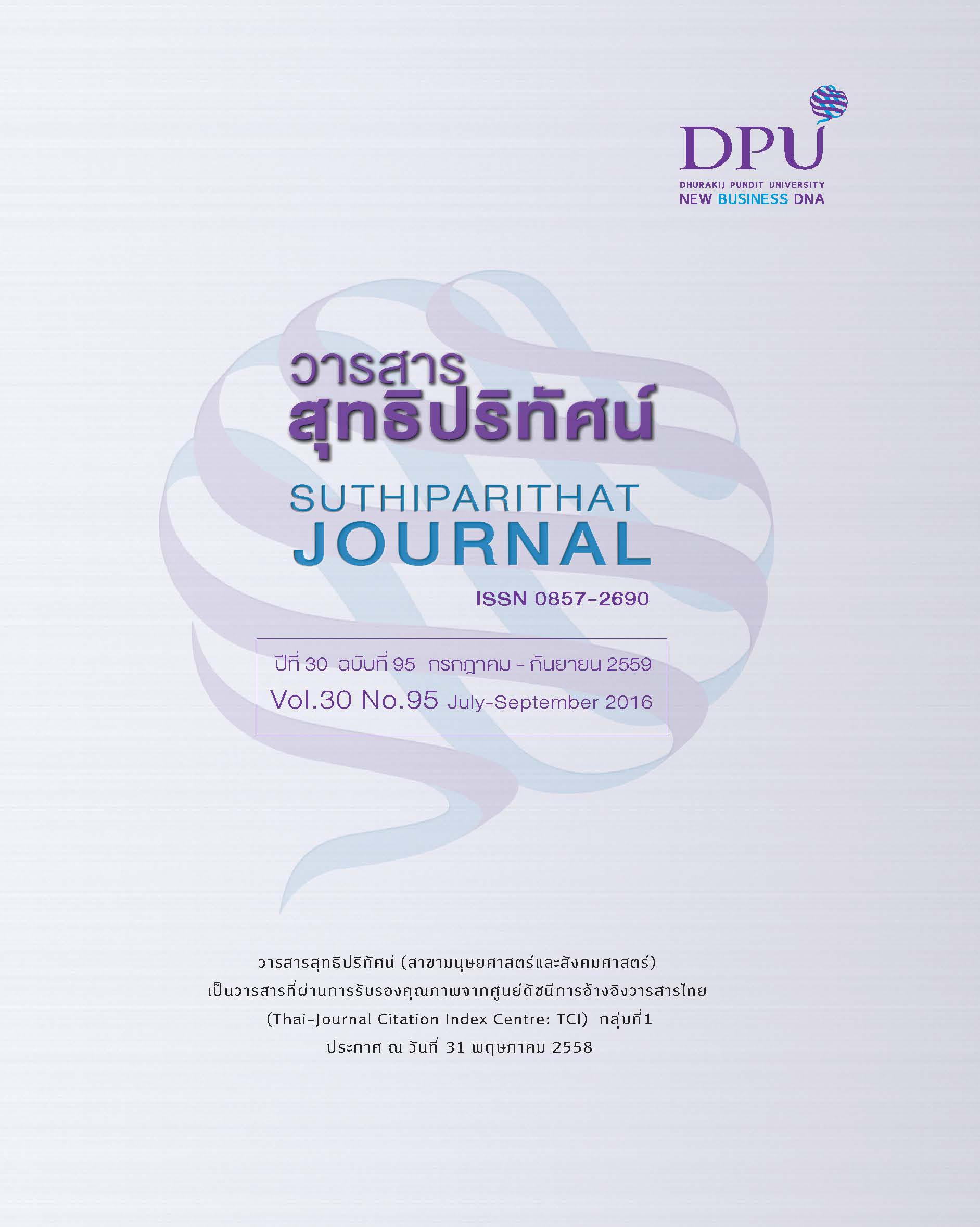ปัจจัยที่มีอิทธิพลต่อความตั้งใจที่จะเป็นผู้ประกอบการของนักศึกษาปริญญาตรี: กรณีศึกษามหาวิทยาลัยกรุงเทพ
คำสำคัญ:
ความตั้งใจที่จะเป็นผู้ประกอบการ, การส่งเสริมการเป็นประกอบการ, ทฤษฎีพฤติกรรมตามแผน, นักศึกษาระดับปริญญาตรี, การวิเคราะห์โมเดลสมการโครงสร้างบทคัดย่อ
การวิจัยครั้งมีวัตถุประสงค์เพื่อศึกษาอิทธิพลของปัจจัยด้านการรับรู้ความสามารถในการเป็นผู้ประกอบการ ทัศนคติต่อการเป็นผู้ประกอบการและบรรทัดฐานทางสังคมที่มีต่อความตั้งใจที่จะเป็นผู้ประกอบการของนักศึกษาระดับปริญญาตรี โดยใช้ทฤษฎีพฤติกรรมตามแผนของ Ajzen (1991) ใช้แบบสอบถามความตั้งใจเป็นผู้ประกอบการที่พัฒนาจากแบบสอบถามความตั้งใจที่จะเป็นผู้ประกอบการของ Linan (2009) เป็นเครื่องมือในการเก็บข้อมูลจากนักศึกษาระดับปริญญาตรีของมหาวิทยาลัยกรุงเทพ จำนวน 777 คน วิเคราะห์ข้อมูลด้วยการวิเคราะห์โมเดลสมการโครงสร้าง ผลการวิจัยพบว่า ทัศนคติต่อการเป็นผู้ประกอบการ บรรทัดฐานทางสังคมและการรับรู้ความสามารถในการเป็นผู้ประกอบการมีอิทธิพลต่อความตั้งใจเป็นผู้ประกอบการของนักศึกษาปริญญาตรี ซึ่งทัศนคติต่อการเป็นผู้ประกอบการมีอิทธิพลต่อความตั้งใจที่จะเป็นผู้ประกอบการสูงที่สุดโดยมีอิทธิพลทั้งทางตรงและทางอ้อม รองลงมาคือ บรรทัดฐานทางสังคมมีอิทธิพลต่อความตั้งใจที่จะเป็นผู้ประกอบการทางอ้อมผ่านทางทัศนคติต่อการเป็นผู้ประกอบการการรับรู้ความสามารถในการเป็นผู้ประกอบการ และท้ายสุดคือการรับรู้ความสามารถในการเป็นผู้ประกอบการมีอิทธิพลทางตรงต่อความตั้งใจที่จะเป็นผู้ประกอบการ
เอกสารอ้างอิง
ชูชัย สมิทธิไกร. (2548). ศักยภาพการเป็นผู้ประกอบการของนักศึกษามหาวิทยาลัยไทย. วารสารสงขลานครินทร์ ฉบับสังคมศาสตร์และมนุษยศาสตร์, 11(3), 255-273.
พรทิพย์ ม่วงมี. (2555). ปัจจัยทางจิตและสังคมที่เกี่ยวข้องกับความตั้งใจเป็นผู้ประกอบการของนักศึกษาชั้นปีที่ 4 มหาวิทยาลัยธรรมศาสตร์. วารสารพฤติกรรมศาสตร์เพื่อการพัฒนา, 4(1), 74-82.
มหาวิทยาลัยกรุงเทพ. (2559). แนะนำมหาวิทยาลัย. สืบค้น 3 พฤศจิกายน 2558, จาก http://www.bu.ac.th/tha/about-bu.html.
ศิริชัย กาญจนวาสี. (2552). ทฤษฎีการทดสอบแบบดั้งเดิม. กรุงเทพฯ: สำนักพิมพ์แห่งจุฬาลงกรณ์มหาวิทยาลัย.
สุชาติ ไตรภพสกุล. (2558). อิทธิพลของปัจจัยแรงจูงใจต่อการเป็นผู้ประกอบการที่มีต่อการเติบโตและความมุ่งหวังที่จะเติบโตของธุรกิจ: กรณีศึกษาประเทศไทย. วารสารสุทธิปริทัศน์, 29(90), 75-93.
สุธีรา อะทะวงษา และสมบูรณ์วัลย์ สัตยารักษ์วิทย์, (2557). คุณลักษณะของการเป็นผู้ประกอบการและลักษณะของสถานประกอบการ ที่มีผลต่อการเจริญเติบโตของวิสาหกิจขนาดกลางและขนาดย่อมของประเทศไทย. วารสารสุทธิปริทัศน์, 28(85), 75-93.
สำนักงานเลขาธิการสภาผู้แทนราษฎร, (2558), วาระปฏิรูปที่ ๑๕ : การสร้างสังคมผู้ประกอบการ. กรุงเทพฯ: สำนักงานเลขาธิการสภาผู้แทนราษฎร.
สำนักงานส่งเสริมวิสาหกิจขนาดกลางและขาดย่อม, สำนักประสานด้านการต่างประเทศ, (2557). การรวบรวมข้อมูล SMEs ในภูมิภาค APEC, สืบค้น 3 พฤศจิกายน 2558, จาก http://www.sme.go.th/th/index.php/data-alert/articles/articles-1
Ajzen, I. (1991). The theory of planned behavior. Organizational behavior and human decision processes, 50(2), 179-211.
Bandura, A. (1997). Self-efficacy: The exercise of control. New York: WH Freeman.
Barclay, D., Higgins, C. & Thompson, R. (1995). The partial least squares (PLS) approach to causal
modeling: Personal computer adoption and use as an illustration. Technology studies, 2(2), 285-309.
Ferreira, J. J., Raposo, M. L., Gouveia Rodrigues, R., Dinis, A., & do Paco, A. (2012). A model of entrepreneurial intention: An application of the psychological and behavioral approaches. Journal of Small Business and Enterprise Development, 19(3), 424-440.
Fornell, C. & Larcker, D. F. (1981). Structural equation models with unobservable variables and measurement error: Algebra and statistics. Journal of marketing research, 18(3), 382-388.
Gurel, E., Altinay, L., & Daniele, R. (2010). Tourism students’ entrepreneurial intentions. Annals of Tourism Research, 37(3), 646-669.
Hair, J. F., Hult, G. T. M., Ringle, C., & Sarstedt, M. (2013). A primer on partial least squares structural equation modeling (PLS-SEM). Thousand Oaks, California: Sage Publications.
Heuer, A. & Liñán, F., (2013), Testing alternative measures of subjective norms in entrepreneurial intention models, International Journal of Entrepreneurship and Small Business, 19(1), 35–50.
Hmieleski, K. M., & Baron, R. A. (2008). When does entrepreneurial self-efficacy enhance versus reduce firm performance?. Strategic Entrepreneurship Journal, 2(1), 57-72.
Kelley, D., Singer, S. & Herrington, M. (2016). Global Entrepreneurship Monitor. 2015/16 Global report, Babson Park, MA.: Babson College and London: London Business School.
Kline, R. B. (2011). Principles and practice of structural equation modeling (3th.). New York, NY:Guilford publications.
Linan, F., & Chen, Y. W. (2009). Development and Cross-Cultural application of a specific instrument to measure entrepreneurial intentions. Entrepreneurship Theory and Practice, 33(3), 593-617.
Linan, F., & Rodriguez-Cohard, J. C. (2015). Assessing the stability of graduates’ entrepreneurial intention and exploring its predictive capacity. Academia Revista Latinoamericana de Administracion, 28(1), 77-98.
Linan, F., Nabi, G., & Krueger, N. (2013). British and Spanish entrepreneurial intentions: A comparative study. Revista de economia Mundial, 33, 73-103.
Ogundipe, S. E., Kosile, B. A., Olaleye, V. I., and Ogundipe, L. O. (2012). Entrepreneurial Intention among Business and Counselling Students in Lagos State University Sandwich Programme. Journal of Education and Practice. 3(14), 64-72.
Shapero, A., & Sokol, L. (1982). Social dimensions of entrepreneurship. In C.A. Kent, D.L. Sexten, & K.H. Vesper (Eds.), Encyclopedia of entrepreneurship (pp.72-90). Englewood Cliffs, NJ: Prentice Hall.
Thompson, E. R. (2009). Individual entrepreneurial intent: construct clarification and development of an internationally reliable metric. Entrepreneurship Theory and Practice, 33(3), 669–694.
Schumacker, R. E., & Lomax, R. G. (2004). A beginner’s guide to structural equation modeling (2nd.). Mahwah, NJ: Lawrence Erlbaum Associates.
ดาวน์โหลด
เผยแพร่แล้ว
รูปแบบการอ้างอิง
ฉบับ
ประเภทบทความ
สัญญาอนุญาต
เนื้อหาและข้อมูลในบทความที่ลงตีพิมพ์ในวารสารสุทธิปริทัศน์ ถือเป็นข้อคิดเห็นและความรับผิดชอบของผู้เขียนบทความโดยตรงซึ่งกองบรรณาธิการวารสาร ไม่จำเป็นต้องเห็นด้วย หรือร่วมรับผิดชอบใด ๆ
บทความ ข้อมูล เนื้อหา รูปภาพ ฯลฯ ที่ได้รับการตีพิมพ์ในวารสารสุทธิปริทัศน์ ถือเป็นลิขสิทธิ์ของวารสารสุทธิปริทัศน์หากบุคคลหรือหน่วยงานใดต้องการนำทั้งหมดหรือส่วนหนึ่งส่วนใดไปเผยแพร่ต่อหรือเพื่อกระทำการใด ๆ จะต้องได้รับอนุญาตเป็นลายลักษณ์อักษรจากวารสารสุทธิปริทัศน์ก่อนเท่านั้น







